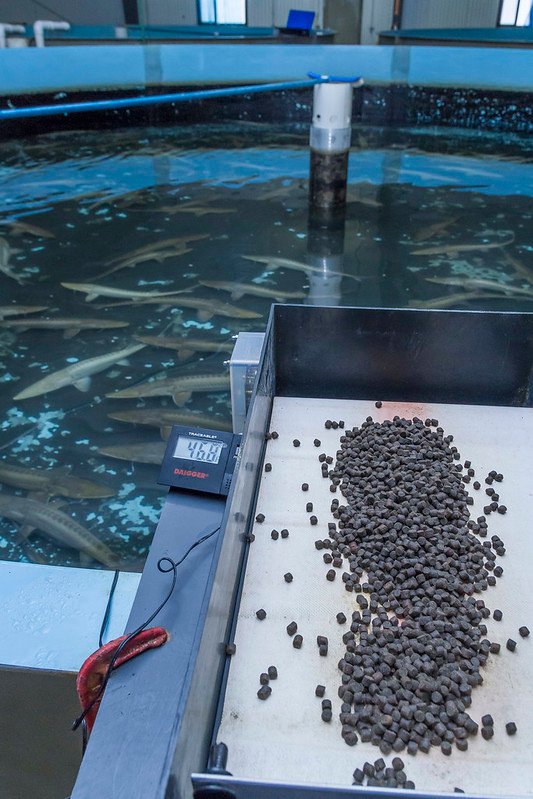BY J. del Carmen*
USA.- With Peruvian trout production at more than 50,000 metric tons (MT) annually, USSEC is focusing on this sector as a good potential for the use of U.S. soy products in aquafeed.
In addition to conferences, seminars, and training courses, USSEC also offers technical support and consultations for select key customers by Vitapro, an international aqua feed mill and USSEC cooperator. These activities serve to discuss trout production procedures and customers’ feeding programs as well as health and management issues in their operations. USSEC consultant Dr. John Hargreaves, a renowned aquaculture consultant and water management and carrying capacity calculations specialist, and Jairo Amezquita, USSEC Aquaculture Program Manager – Americas, helped to facilitate this program for Peruvian trout producers.
Dr. Hargreaves provided technical support to trout farms visited in Lake Titicaca, Lake Lagunillas, and Lake Langui. Trout are grown in net pens and fed high-quality aquafeeds. Presentations were made to groups of trout farm owners, workers, and other stakeholders at each lake visited. The presentation broadly addressed sustainable production in lakes with long water turnover times. Topics included a brief market summary; factors that affect trout growth in cages, with an emphasis on temperature and oxygen; feeds, feeding programs and feeding practices; impacts of waste loading on lakes, sustainable carrying capacity level, and methods to reduce nutrient loading; disease management and zoning; and governance and licensing. Before beginning each farm meeting and presentation, USSEC’s role in promoting the use of U.S. soybean meal in aquafeeds used to support trout farming in Peru was explained. Also, the use and sustainability of U.S. Soy in trout feeds was explained to growers and stakeholders in one-on-one or small-group meetings and at formal speaking events. Discussions were held about increasing the incorporation rate of soybean meal or other soy products with the technical representatives and the general manager of the aquaculture portfolio of the Vitapro aquafeed company.
The main recommendations from meetings and discussions with trout farmers in Peru are as follows:
– Establish producer associations. For sustainable production of trout in cages, collective action is necessary to address disease risks and develop area or zonal management of production within the limits of lake carrying capacity.
– Develop a producer code of conduct. This is the next step for most producer associations.
– Foster an enabling regulatory environment. Producers and feed company technical staff may be able to influence the regulatory environment that is conducive to sustainable production through engagement with regulators.
Stay Always Informed
Join our communities to instantly receive the most important news, reports, and analysis from the aquaculture industry.
– Adjust cage carrying capacity to oxygen supply. In cage culture, oxygen supply is a function of dissolved oxygen concentration multiplied by water flow rate (current speed). In Lake Titicaca, experience suggests that 15 kg/m3 is possible for large fish and 5-6 kg/m3 for juveniles. Especially in Lake Langui, water movement appeared to be low and carrying capacity was limited to 8-12 kg/m3. Producers should consider emergency measures for oxygen supply during periods when cage density is high and water movement is low. Cylinders of compressed pure oxygen gas connected by tubing from the regulator to a diffuser array is recommended in such emergency situations.
USSEC will continue supporting the sustainable growth of the aquaculture industry around the world as a source of animal protein production for feeding humanity.
Source: U.S. Soybean Export Council
Editor at the digital magazine AquaHoy. He holds a degree in Aquaculture Biology from the National University of Santa (UNS) and a Master’s degree in Science and Innovation Management from the Polytechnic University of Valencia, with postgraduate diplomas in Business Innovation and Innovation Management. He possesses extensive experience in the aquaculture and fisheries sector, having led the Fisheries Innovation Unit of the National Program for Innovation in Fisheries and Aquaculture (PNIPA). He has served as a senior consultant in technology watch, an innovation project formulator and advisor, and a lecturer at UNS. He is a member of the Peruvian College of Biologists and was recognized by the World Aquaculture Society (WAS) in 2016 for his contribution to aquaculture.




